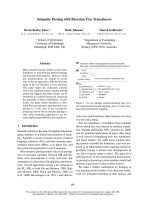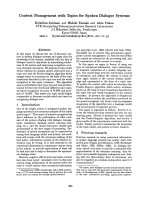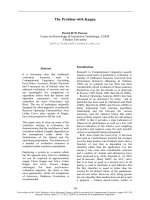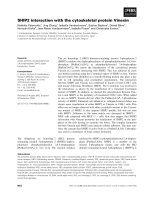Báo cáo khoa học: "Epithelioid sarcoma with muscle metastasis detected by positron emission tomography" docx
Bạn đang xem bản rút gọn của tài liệu. Xem và tải ngay bản đầy đủ của tài liệu tại đây (2.4 MB, 5 trang )
BioMed Central
Page 1 of 5
(page number not for citation purposes)
World Journal of Surgical Oncology
Open Access
Case report
Epithelioid sarcoma with muscle metastasis detected by positron
emission tomography
Akio Sakamoto*
1,2
, Osamu Jono
2
, Minako Hirahashi
3
, Masafumi Oya
3
,
Yukihide Iwamoto
1
and Ken Arai
2
Address:
1
Department of Orthopaedic Surgery, Graduate School of Medical Sciences, Kyushu University, 3-1-1 Maidashi, Fukuoka, 812-8582,
Japan,
2
Department of Orthopaedic Surgery, 3-83 Yoshio, Iizuka, Iizuka Hospital, 820-8505, Fukuoka, Japan and
3
Department of Pathology, 3-
83 Yoshio, Iizuka, Iizuka Hospital, 820-8505, Fukuoka, Japan
Email: Akio Sakamoto* - ; Osamu Jono - ; Minako Hirahashi -
u.ac.jp; Masafumi Oya - ; Yukihide Iwamoto - ; Ken Arai -
* Corresponding author
Abstract
Background: Epithelioid sarcoma is an uncommon high-grade sarcoma, mostly involving the
extremities.
Case presentation: A 33-year-old man was referred to our institute with a diagnosis of
Volkmann's contracture with the symptom of flexion contracture of the fingers associated with
swelling in his left forearm. Magnetic resonance imaging (MRI) showed abnormal signal intensity,
comprising iso-signal intensity on T1- and high-signal intensity on T2-weighted images surrounding
the flexor tendons in the forearm. Diagnosis of epithelioid sarcoma was made by open biopsy, and
amputation at the upper arm was then undertaken. [
18
F]-2-fluoro-2-deoxy-D-glucose-positron
emission tomography (FDG-PET) detected multiple lesions with an increased uptake in the right
neck, the bilateral upper arms and the right thigh, as well as in the left axillary lymph nodes, with
maximum standardized uptake value (SUVmax) ranging from 2.0 to 5.5 g/ml. Magnetic resonance
imaging confirmed that there was a lesion within the right thigh muscle which was suggestive of
metastasis, even though the lesion was occult clinically.
Conclusion: Increased uptake on FDG-PET might be representative of epithelioid sarcoma, and
for this reason FDG-PET may be useful for detecting metastasis. Muscle metastasis is not well
documented in epithelioid sarcoma. Accordingly, the frequency of muscle metastasis, including
occult metastasis, needs to be further analyzed.
Background
Epithelioid sarcoma was first described in 1970 [1]. Epi-
thelioid sarcoma is an uncommon slow-growing malig-
nant soft-tissue mass, usually found in the extremities,
particularly in the hand and foot. The tumor is known to
be associated with a high incidence of local recurrence
and metastasis. The tumor is mostly prevalent in young
adults aged between 20 and 40 years old [2]. The overall
survival rates have been reported be 92.4%, 86.9% and
72.4% at 5, 10 and 15 years, respectively [3]. Epithelioid
sarcoma has a diagnostic problem clinically, because its
symptoms are sometimes similar to benign conditions,
including inflammatory or granulomatous lesions [4].
Published: 15 August 2008
World Journal of Surgical Oncology 2008, 6:84 doi:10.1186/1477-7819-6-84
Received: 29 May 2008
Accepted: 15 August 2008
This article is available from: />© 2008 Sakamoto et al; licensee BioMed Central Ltd.
This is an Open Access article distributed under the terms of the Creative Commons Attribution License ( />),
which permits unrestricted use, distribution, and reproduction in any medium, provided the original work is properly cited.
World Journal of Surgical Oncology 2008, 6:84 />Page 2 of 5
(page number not for citation purposes)
[
18
F]-2-fluoro-2-deoxy-D-glucose-positron emission tom-
ography (FDG-PET) has recently been used to assess vari-
ous tumors. PET is evaluated using the standardized
uptake value (SUV). An increased uptake of FDG-PET in
cells reflects increased glucose metabolism as a result of
various factors such as increased glucose transporters,
high levels of hexokinase and a reduction in glucose-6-
phosphatase [5,6]. FDG-PET has been reported to be use-
ful for distinguishing malignant tumors from benign
tumors in the case of lung tumors [7], head and neck
tumors [8] and breast tumors [9]. As for bone and soft-tis-
sue tumors, it has been reported that malignant tumors
tend to have a higher SUV than benign tumors, with the
cut-off point of SUV of 1.83 g/ml (sensitivity: 0.86, specif-
icity: 0.42), 2.14 g/ml (sensitivity: 0.79, specificity: 0.52)
and 3.23 g/ml (sensitivity: 0.57, specificity: 0.74) [10,11].
The same research group also reported that the cut-off
point of SUV in bone lesions was 2.3 g/ml (sensitivity:
0.73), and in soft-tissue lesions it was 2.8 g/ml (sensitiv-
ity: 0.88) [10].
In this report, we present a case of epithelioid sarcoma
with the symptom of Volkmann's contracture character-
ized by a claw-like deformity of the hand and fingers asso-
ciated with contracture of the muscles in the forearm.
Furthermore, FDG-PET detected occult metastasis to the
muscle clinically, in addition to metastasis to the regional
lymph nodes.
Case presentation
A thirty-three-year-old man noticed extension disturbance
of the left fingers, 7 months prior to the initial evaluation
in our institute. He began to feel tension and pain in the
forearm when he extended his fingers. He visited a local
hospital 1 month after onset. A swelling in his left forearm
appeared and this worsened gradually. The symptoms did
not resolve, and the patient was then referred to our insti-
tute with a diagnosis of Volkmann's contracture (Figure
1A). Plain radiographs showed irregularity of the surface
of the ulna, which was compatible with periostitis (Figure
1B). Magnetic resonance imaging (MRI) demonstrated a
Epithlioid sarcoma in the forearmFigure 1
Epithlioid sarcoma in the forearm. Flexion contracture of the fingers can be seen (A). Plain radiograph shows irregular
surface of the ulna (B). MRI of the forearm shows an abnormal lesion with iso-signal intensity on T1-weighted image (top) and
high-signal intensity on T2-weighted image (middle) (C). Enhancement with gadolinium can be seen on T1-weighted fat-sup-
pression image (bottom) (C).
World Journal of Surgical Oncology 2008, 6:84 />Page 3 of 5
(page number not for citation purposes)
lesion surrounding the flexor tendons in the flexor com-
partments of the forearm with iso-signal intensity to the
surrounding muscle tissue on T1-weighted images and
heterogeneous high-signal intensity on T2-weighted
images. The lesion was enhanced by gadolinium on T1-
weighted images (Figure 1C). Based on these clinical
symptoms and images, the cause of the Volkmann's con-
tracture was explained as being due to chronic inflamma-
tion caused by repeated stress in the forearm, based on the
facts that he was a carpenter and he used his upper extrem-
ities often. This was despite the fact that he was right-
handed.
At our institute, surgery was undertaken not only to
release the contracture, but also to obtain a biopsy speci-
men to diagnose the cause of the contracture. The surgery
findings showed that the tendons had adhered to each
other with cicatricial-like tissue without any obvious mass
lesion. Then, release of the adhered flexor tendons was
undertaken. The cicatricial-like tissue was sampled for
analysis, and histologically, it was found to be composed
of rounded or polygonal epithelioid cells, arranged in
sheets or a solid trabeculae pattern. Degeneration and
necrosis were also observed (Figure 2A). The neoplastic
cells had vesicular nuclei and prominent nucleoli, with
characteristic eosinophilic glassy cytoplasm (Figure 2B).
Immunohistochemically, the tumor cells were positive for
an epithelial marker of EMA (epithelial membrane anti-
gen) and cytokeratins (AE1/AE3, CAM5.2), but negative
for S-100 protein, which is a Schwann-cell marker. These
histological findings were typical of epithelioid sarcoma.
However, epithelioid sarcoma needs to be differentiated
from malignant soft-tissue tumors of epithelioid malig-
nant peripheral nerve sheath tumor (MPNST) and malig-
nant melanoma. Unlike epithelioid sarcoma, epithelioid
MPNST tends to stain strongly for S-100 protein and vir-
tually never expresses cytokeratins, whereas malignant
melanoma virtually always expresses S-100 protein [4].
Some epithelioid sarcomas are also difficult to distinguish
from epithelial tumor of ulcerating squamous cell carci-
Epithelioid sarcoma in the forearm shows atypical epithelioid cells in sheets associated with tumor necrosis (right portion) (A)Figure 2
Epithelioid sarcoma in the forearm shows atypical epithelioid cells in sheets associated with tumor necrosis
(right portion) (A). The neoplastic cells have nuclei and prominent nucleoli, with eosinophilic glassy cytoplasm (B). (Hema-
toxylin and Eosin original magnification; A, ×150; B, ×200).
World Journal of Surgical Oncology 2008, 6:84 />Page 4 of 5
(page number not for citation purposes)
noma. However, epithelioid sarcoma lacks keratin pearls,
as was true for the current case [4]. Taken together, a diag-
nosis of epithelioid sarcoma was made in the current case.
CT showed no evidence of pulmonary metastasis, but it
showed mild swelling of the axillary lymph nodes, which
could have been possible metastasis, or simply non-spe-
cific swelling due to the biopsy procedure. Amputation
above the elbow was undertaken. Three months after the
amputation, bone scintigraphy showed no evidence of
abnormal findings suggestive of metastasis to the bone
(data not shown). However, CT showed increased size of
the axillary lymph nodes, suggesting that these lymph
nodes were actually metastasized (Figure 3B). For further
examination, FDG-PET was undertaken, and it detected
multiple lesions with an increased uptake in the right neck
(SUVmax; 4.6 g/ml), right upper arm (SUVmax; 4.1 g/ml),
left upper arm (SUVmax; 4.2 g/ml), right thigh (SUVmax;
5.5 g/ml) left thigh (SUVmax; 2.0 g/ml), back (SUVmax;
3.6 g/ml), and lower back (SUVmax; 4.6 g/ml), as well as
the left axilla (SUVmax; 3.9 g/ml) (Figure 3A). As for the
right neck lesion, ultrasonography and CT failed to detect
swelling of the lymph node just after FDG-PET examina-
tion, although the swollen lymph lesion was confirmed
physically 3 months later (data not shown). The right
thigh lesion with an increased uptake on FDG-PET was
not palpable, and had no tenderness on physical exami-
nation. However, MRI demonstrated a nodular metastatic
lesion measuring 2 × 2.5 cm which was located within the
thigh muscle with iso-signal intensity to the muscle tissue
on T1 images and heterogeneous high-signal intensity on
T2-weighted images. Gadolinium enhancement on T1-
weighted images was seen in the lesion. The surrounding
reactive lesions were seen mainly longitudinally (Figure
3C). The thigh lesion was still not palpable 3 months after
the FDG-PET examination.
Discussion
A diagnosis of epithelioid sarcoma is challenging clini-
cally, because epithelioid sarcoma is likely to be confused
with a variety of benign and malignant conditions [4].
Due to this diagnostic difficulty, it has been reported that
the median interval between observing the initial symp-
toms, making a diagnosis, and starting treatment is 3.5
months, ranging between 1 and 36 months [2]. In the cur-
rent study, 7 months passed before a biopsy was under-
taken for diagnosis, because the initial clinical diagnosis
had been benign inflammatory lesion resulting in Volk-
mann's contracture. Furthermore, MRI failed to detect any
obvious space-occupying lesion, and it was less suggestive
of a solid tumor. Generally, in epithelioid sarcoma, necro-
sis within a neoplasm is a common finding. When the
tumor spreads within a fascia or aponeurosis, it forms fes-
toon-like or garland-line bands punctuated by areas of
necrosis [4]. The spread pattern of the epithelioid sarcoma
seems to have caused the clinical symptoms of Volk-
mann's contracture in the current case.
SUV in FDG-PET of malignant bone and soft-tissue
lesions has been reported to be higher than that of benign
bone and soft-tissue lesions, with the cut-off point rang-
ing from 1.83 to 3.23 [10,11]. In another report, the cut-
off point of SUV in FDG-PET in soft-tissue lesions has
been reported to be 2.8 g/ml [10]. In a previous study,
FDG-PET was reported to be useful for verifying adjacent
bone marrow infiltration in a case of epithelioid sarcoma,
in which there are 2 foci in the right gluteus (SUVmax;
4.0–6.1 g/ml) and sacrococcygeal (SUVmax; 7.0–7.5 g/
ml) regions [12]. In the current case, the SUVmax of FDG-
PET in the multiple metastatic lesions ranged from 2.0 to
5.5 g/ml. Taken together with the current case and the
reported case, it might be possible that an increased
uptake in FDG-PET is characteristic of epithelioid sar-
coma.
Metastatic lesions of epithelioid sarcomaFigure 3
Metastatic lesions of epithelioid sarcoma. FDG-PET
identifies lesions with an increased uptake in the right neck
(SUVmax; 4.6), right upper arm (SUVmax; 4.1 g/ml), left
upper arm (SUVmax; 4.2 g/ml), right thigh (SUVmax; 5.5 g/
ml) left thigh (SUVmax; 2.0 g/ml), back (SUVmax; 3.6 g/ml),
and lower back (SUVmax; 4.6 g/ml), as well as the left axilla
(SUVmax; 3.9 g/ml) (arrows) (A). CT with contrast medium
shows a swollen axillary lymph node (B). Sagittal MRI section
of the right thigh shows a nodular lesion associated with
prominent longitudinal abnormal signal intensity on T2-
weighted image (C). The nodular lesion shows iso-intensity
on T1-weighted fat-suppression image (top), and heterogene-
ous high-intensity on T2-weighted image (middle) (D).
Enhancement with gadolinium can be seen on T1-weighted
fat-suppression image (bottom) (D).
Publish with BioMed Central and every
scientist can read your work free of charge
"BioMed Central will be the most significant development for
disseminating the results of biomedical research in our lifetime."
Sir Paul Nurse, Cancer Research UK
Your research papers will be:
available free of charge to the entire biomedical community
peer reviewed and published immediately upon acceptance
cited in PubMed and archived on PubMed Central
yours — you keep the copyright
Submit your manuscript here:
/>BioMedcentral
World Journal of Surgical Oncology 2008, 6:84 />Page 5 of 5
(page number not for citation purposes)
In the current study, without FDG-PET, only the metasta-
sis to the lymph nodes could be detected by CT, because
metastasis to the muscle was occult clinically, even 3
months after the FDG-PET examination. The metastatic
rate of epithelioid sarcoma has been reported to be 45%,
and the most common sites of metastasis are the lung
(51%), regional lymph nodes (34%), the scalp (22%) and
bone (13%), while metastasis to the soft-tissue, including
muscle, is thought to be less common [4]. However, tak-
ing into consideration the clinically occult muscle metas-
tasis in the current case, it is possible that clinically occult
metastasis, such as to the muscle, is much more common
than has been thought. There has been a report that the
presence of lymph node metastases is not a significantly
unfavorable factor [2], in contrast to other studies with
conflicting results [4,13-18]. It has also been suggested
that lymph node metastases may be the first symptom of
widely disseminated disease rather than a purely regional
process [16].
Conclusion
In conclusion, we have reported a case of epithelioid sar-
coma with the symptom of Volkmann's contracture. The
current case should act as a reminder that Volkmann's
contracture can be a symptom of epithelioid sarcoma in
the forearm, and this reminder should help avoid a delay
in the commencement of treatment. Multiple metastases
to the lymph nodes and muscle had an increased uptake
in FDG-PET, and the increased uptake may be representa-
tive of epithelioid sarcoma. Metastasis to the muscle tissue
has not been well described so far. Further reports are nec-
essary for the precise frequency of muscle metastasis to be
ascertained. In that case, FDG-PET might be useful for
detecting such metastasis.
Competing interests
The authors declare that they have no competing interests.
Authors' contributions
AS drafted the manuscript. MH and MO are pathologists
who helped with the discussion. AS, OJ and KA are sur-
geons who carried out the operation. YI is the Professor of
the Department of Orthopaedic Surgery of Kyushu Uni-
versity who approves all relevant manuscripts. All authors
read and approved the final manuscript.
Acknowledgements
Written informed consent was obtained from the patient and his family.
The English used in this manuscript was revised by Miss K. Miller (Royal
English Language Centre, Fukuoka, Japan).
References
1. Enzinger FM: Epitheloid sarcoma. A sarcoma simulating a
granuloma or a carcinoma. Cancer 1970, 26(5):1029-1041.
2. de Visscher SA, van Ginkel RJ, Wobbes T, Veth RP, Ten Heuvel SE,
Suurmeijer AJ, Hoekstra HJ: Epithelioid sarcoma: Still an only
surgically curable disease. Cancer 2006, 107(3):606-612.
3. Casanova M, Ferrari A, Collini P, Bisogno G, Alaggio R, Cecchetto G,
Gronchi A, Meazza C, Garaventa A, Di Cataldo A, Carli M, Italian Soft
Tissue Sarcoma Committee: Epithelioid sarcoma in children and
adolescents: a report from the Italian Soft Tissue Sarcoma
Committee. Cancer 2006, 106(3):708-717.
4. Enzinger FM, Weiss SW: Soft tissue tumors. Volume 4th. St. Louis
, CV Mosby; 2001.
5. Smith TA: FDG uptake, tumour characteristics and response
to therapy: a review. Nucl Med Commun 1998, 19(2):97-105.
6. Gallagher BM, Fowler JS, Gutterson NI, MacGregor RR, Wan CN,
Wolf AP: Metabolic trapping as a principle of radiopharma-
ceutical design: some factors responsible for the biodistribu-
tion of [18F] 2-deoxy-2-fluoro-D-glucose. J Nucl Med 1978,
19(10):1154-1161.
7. Gupta NC, Maloof J, Gunel E: Probability of malignancy in soli-
tary pulmonary nodules using fluorine-18-FDG and PET. J
Nucl Med 1996 , 37(6):943-948.
8. Lapela M, Grenman R, Kurki T, Joensuu H, Leskinen S, Lindholm P,
Haaparanta M, Ruotsalainen U, Minn H: Head and neck cancer:
detection of recurrence with PET and 2-[F-18]fluoro-2-
deoxy-D-glucose. Radiology 1995 , 197(1):205-211.
9. Adler LP, Crowe JP, al-Kaisi NK, Sunshine JL: Evaluation of breast
masses and axillary lymph nodes with [F-18] 2-deoxy-2-
fluoro-D-glucose PET. Radiology 1993 , 187(3):743-750.
10. Tian M, Zhang H, Oriuchi N, Higuchi T, Endo K: Comparison of
11C-choline PET and FDG PET for the differential diagnosis
of malignant tumors. Eur J Nucl Med Mol Imaging 2004,
31(8):1064-1072.
11. Zhang H, Tian M, Oriuchi N, Higuchi T, Watanabe H, Aoki J, Tanada
S, Endo K:
11C-choline PET for the detection of bone and soft
tissue tumours in comparison with FDG PET. Nucl Med Com-
mun 2003, 24(3):273-279.
12. Chen YW, Huang MY, Chang CC, Lee CS, Liao YM, Chiu SS, Chang
TT: FDG PET/CT findings of epithelioid sarcoma in a pediat-
ric patient. Clin Nucl Med 2007, 32(11):898-901.
13. Chase DR, Enzinger FM: Epithelioid sarcoma. Diagnosis, prog-
nostic indicators, and treatment. Am J Surg Pathol 1985,
9(4):241-263.
14. Prat J, Woodruff JM, Marcove RC: Epithelioid sarcoma: an analy-
sis of 22 cases indicating the prognostic significance of vascu-
lar invasion and regional lymph node metastasis. Cancer 1978,
41(4):1472-1487.
15. Bos GD, Pritchard DJ, Reiman HM, Dobyns JH, Ilstrup DM, Landon
GC: Epithelioid sarcoma. An analysis of fifty-one cases. J Bone
Joint Surg Am 1988, 70(6):862-870.
16. Callister MD, Ballo MT, Pisters PW, Patel SR, Feig BW, Pollock RE,
Benjamin RS, Zagars GK: Epithelioid sarcoma: results of con-
servative surgery and radiotherapy. Int J Radiat Oncol Biol Phys
2001, 51(2):384-391.
17. Evans HL, Baer SC: Epithelioid sarcoma: a clinicopathologic
and prognostic study of 26 cases. Semin Diagn Pathol 1993,
10(4):286-291.
18. Spillane AJ, Thomas JM, Fisher C: Epithelioid sarcoma: the clin-
icopathological complexities of this rare soft tissue sarcoma.
Ann Surg Oncol 2000, 7(3):218-225.









